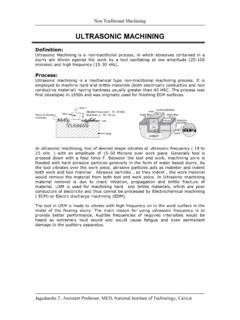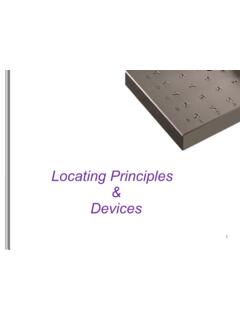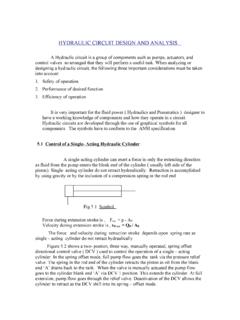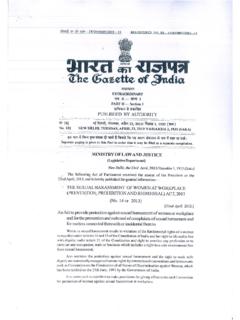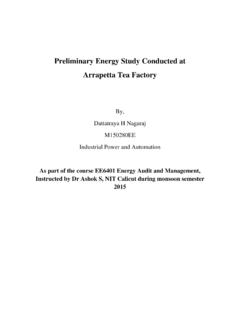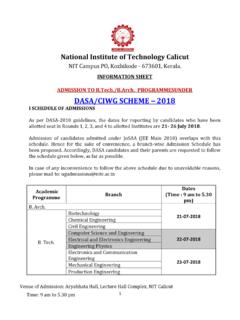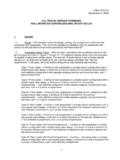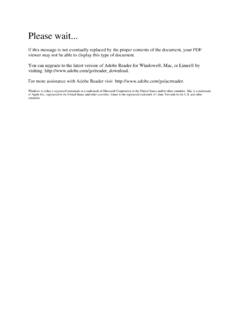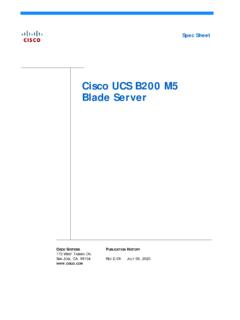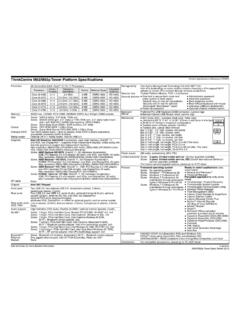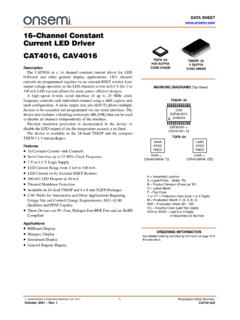Transcription of UNIT 6 DESIGN OF SHEET METAL, Design of Sheet Metal ...
1 17 DESIGN of SHEET Metal , blanking and Piercing ToolsUNIT 6 DESIGN OF SHEET Metal , blanking AND PIERCING TOOLS Structure Introduction Objectives Description of Press Working Tools Source of Power Type of Frames Fundamentals of Press Operation Press Working Terminology Types and Applications of blanking and Piercing Die Principle of SHEET Metal Working and Piercing Tools Plastic Deformation Shear Summary Key Words INTRODUCTION SHEET Metal working may be defined as a chip-less manufacturing process by which various components are made from SHEET Metal . The thickness of SHEET is generally less than 20 mm. The machine used for SHEET Metal working is called press.
2 The main features of a press are: A frame which supports the ram or slide, a bed, a source of mechanism for operating the ram in line with and normal to the bed. The ram is equipped with suitable punch and die block is attached to the bed. The SHEET Metal working components are produced by downward motion of punch and towards the die block. The punch and die block assembly is called die set. These operations are usually done at room temperature. Objectives After studying this unit, you should be able to identifying various press working tools, know various piercing and blanking operation, and understand the principle of SHEET Metal working. DESCRIPTION OF PRESS WORKING TOOLS Press working tools include variety of press.
3 The press may be classified according to source of power; type of frame; method of actuation of slides; and the number of slides incorporating the type of the work. Source of Power The presses are classified according to the source of power used. The two main source of power for applying force to the ram or slide of a press are mechanical and hydraulic. The linear movement of the ram is obtained with the help of a flywheel driven system in mechanically operated press. The heavy flywheel absorbs energy from the motor continuously and delivers its stored energy to the workpiece when required. The flywheel is attached to the main shaft of the press (non-geared) or it is attached to the main shaft with the help of gear train.
4 For short stroke and low tonnage, non-geared drives are useful. Number of strokes per minute is usually quite high for non-gear drives. 18 DESIGN of Metal Shaping Tools Gear train may contain single or double reduction gear. The single reduction gear is suited for heavier blanking operations or shallow blanking . Double reduction gear is used for high tonnage, but with less number of strokes per minute. These are faster than hydraulic presses and require less maintenance and capital cost. Hydraulic presses consist of large cylinder and piston arrangement coupled to a hydraulic pump. The piston and press ram form one unit. The ram can be operated by oil press on the piston in the cylinder. The capacity of hydraulic press depends upon the cross section area of the piston and pressure developed by the pump.
5 The hydraulic press can exert full pressure at any position of the ram stroke. The speed and pressure is constant throughout the entire stroke. It is easy to operate. Type of Frames The presses are classified according to the type of frames such as gap frame and straight side frame. Presses with Gap Frame Presses with gap frame are produced with solid frames in a vertical or inclined position. They are cut back in the form of letter C below the ram so that strip is fed from the side. Some presses have open-back so that strip is fed from front to back. A press is inclined so that the parts may fall through the open-back by gravity. Now-a-days, open-back inclination (OBI) is widely used for blanking and piercing operations on small workpieces.
6 Presses with Straight Side Frame Presses with straight side frame consist of a slide or ram which travels up and down between two straight slides or housings. They are extensively used for large and heavy work. The size of a press is limited due to the presence of housings. It has longer strokes due to the frame construction. These presses are further classified as single point, two point and four point suspensions, depending upon the number of connections between the slide and the main drive shaft. According to the Number of Slides There are three presses according to the number of slides, viz. single-action presses, double-action presses and triple-action presses. A single-action press has one slide, whereas a double-action press has two slides, viz.
7 One inner and the other outer slide. It is generally used for drawing operation in which outer slide carries the blank holder and inner slide carries the punch. Outer slide has shorter stroke than inner. Two slides move in the same direction and against the fixed bed of the press. The working of a triple-action press is same as the double-action press with the addition of third ram. Three rams are located in the press bed. It moves upwards immediately after other two ram moves down. All three actions are properly synchronized for drawing, redrawing and forming. According to the Method of Actuation (Slide) These presses consist of flywheel attached to the main shaft. The rotary motion of flywheel is converted into the linear motion of the slide or ram.
8 This is achieved by using crankpins or eccentrics into the main drive shaft. The number of points of suspension of the slide determines the number of throws or eccentric on the main shaft. The points of suspensions are places where pressure is transmitted by connection to the slide. The shut height of the press can be varied with the help of adjustable connecting rods or pitmans. The main advantage of eccentric is that it offers more surface area for bearing the support for pitman. The limitation of eccentric is that the length of stroke is limited. Crankshaft driven device provides longer strokes. 19 DESIGN of SHEET Metal , blanking and Piercing ToolsThe slides are also actuated by cams, toggle, rack and pinions, screws and knuckles.
9 Fundamentals of Press Operation The force by which press ram is able to exert safely is called tonnage of the press. Press slides exert a force which is greater than the rated tonnage because of built-in safety factor. The tonnage of hydraulic press is equal to the product of the piston area and oil pressure in cylinder. The tonnage is varied by changing the oil pressure. Tonnage of mechanical press is equal to the size of bearings for the crankshaft or eccentric. The tonnage of mechanical press is approximately equal to the product of shear stress of crank shaft material and area of crankshaft bearings. The tonnage of mechanical press is maximum when the slide is near to the bottom of its stroke. Stroke Reciprocating motion of a press slide is called the stroke.
10 Stroke is expressed as the number of inches between terminal points of the motion. The stroke is constant for mechanical press while it is adjustable for hydraulic press. Shut Height The distance from the top of the bed to the bottom of the slide with the stroke down and the adjustment up is called shut height. Die Space Die space is the area available for mounting dies in the press. Press Working Terminology A simple cutting die is shown in Figure Shank Ram Back Up Plate Guide Post Bushing Punch Holder Punch Plate Punch Guide Post Die Block Die Holder Bolster Plate Bed Figure : Simple Cutting Die Bed The bed is lower part of press frame that serves as a table on which a bolster plate is mounted. Bolster Plate Bolster plate is a thick plate secured to the press bed, which is used for locating and supporting the die assembly.

